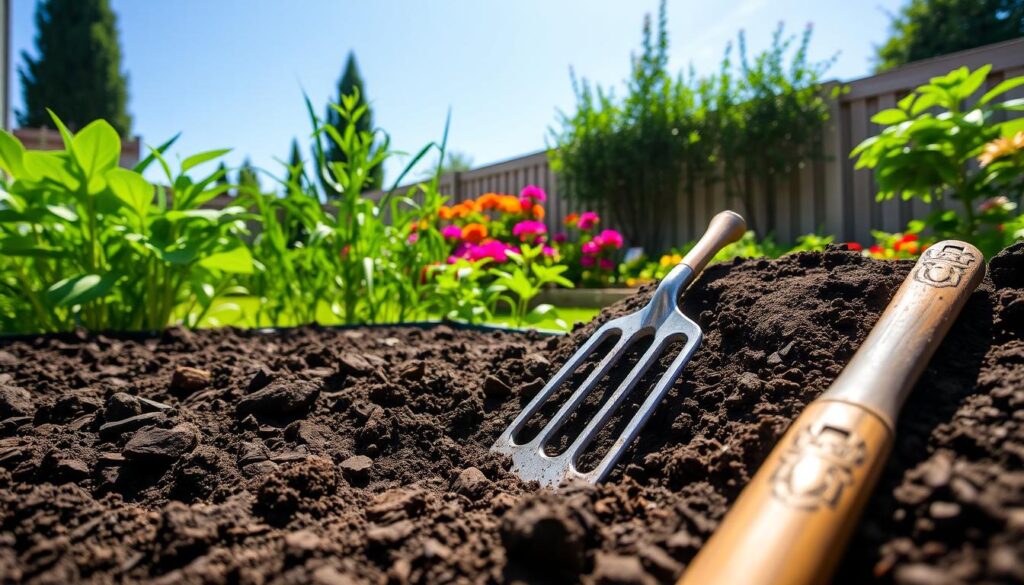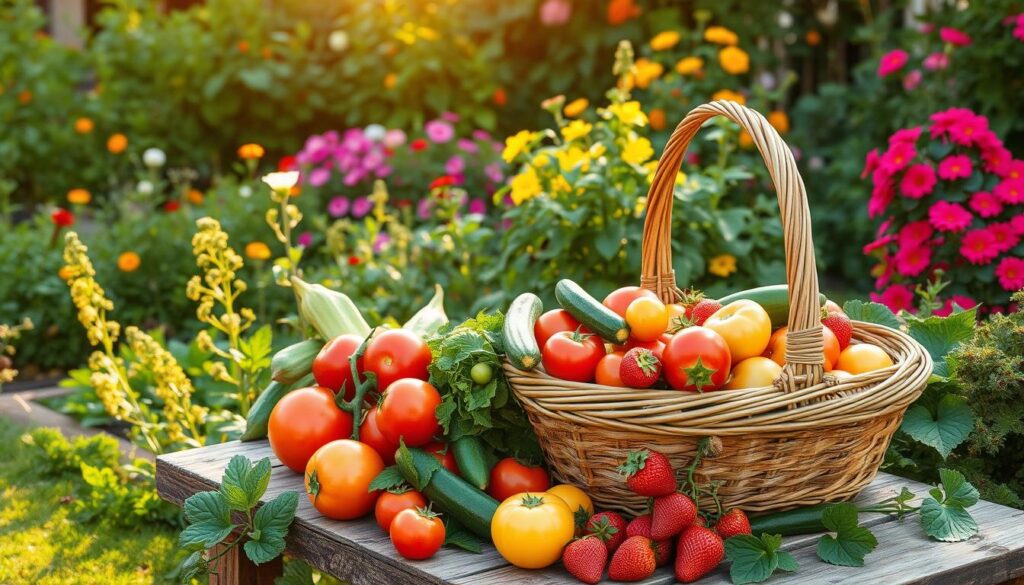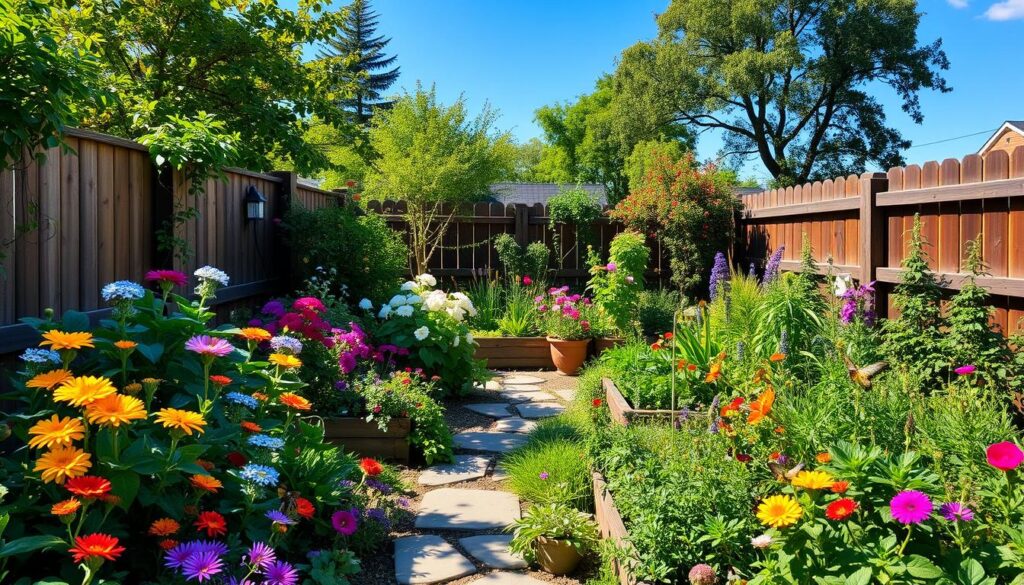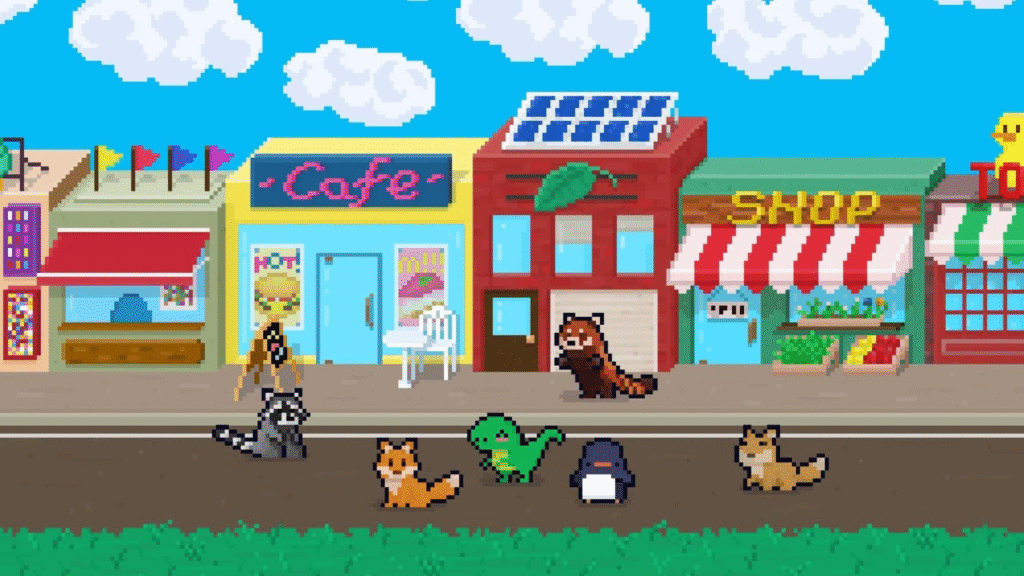Welcome to the world of home gardening! This guide is perfect for both seasoned gardeners and beginners.
Learn how to turn your outdoor space into a lush oasis full of fresh produce and beauty.
Home gardening brings many joys, like watching your plants grow and enjoying fresh food from your garden.
This article will share expert tips to help you create a successful and sustainable garden. It will make your senses happy and your soul nourished.
Table of Contents
ToggleKey Takeaways
- Discover the art of cultivating a thriving backyard garden
- Learn how to select the right plants for your climate and space
- Uncover the secrets to optimal soil preparation and nutrient management
- Master effective watering strategies to keep your garden hydrated
- Explore natural and organic pest and disease management solutions
- Savor the fruits of your labor by harvesting and preserving your bounty
- Embrace sustainable gardening practices for an eco-friendly oasis
Home Gardening: The Art of Cultivating Your Backyard Paradise
Start enjoying home gardening and turn your backyard into a lush oasis. It doesn’t matter if you’re new to gardening or have years of experience.
Growing your own food and creating a peaceful garden brings many rewards.
Unlock the Joys of Homegrown Produce
There’s nothing like growing your own fruits and veggies. You get to see your plants grow and enjoy the taste of homegrown produce.
Imagine picking a ripe tomato or fresh lettuce from your garden, knowing it’s chemical-free.
Create a Sanctuary for Relaxation and Beauty
A beautiful backyard paradise can be a peaceful retreat. Plant flowers, herbs, and greenery to make a garden sanctuary that’s good for your soul.
Your backyard garden can be a place for calm or fun, a true oasis of relaxation and beauty.
“Gardening is the art that uses flowers and plants as paint, and the soil and sky as canvas.” – Elizabeth Murray
Home gardening can change your life, turning your backyard into a paradise. Here, you’ll find homegrown produce and a garden sanctuary for relaxation.
Planning Your Backyard Garden: A Strategic Approach
Creating a great backyard garden needs careful planning. Whether you’re starting fresh or updating your space, learning backyard garden planning is crucial.
It helps you make a beautiful, productive, and lush oasis.
First, measure your backyard space. Look at any existing features like trees or sheds. This helps you plan where to put your raised beds and paths.
Then, check how much sunlight your backyard gets. Plants need different amounts of sun. Knowing this lets you place your plants right for growth.
After checking your space and sun, start designing your garden. Sketch out ideas, trying different layouts. Use raised beds and vertical gardening to save space.
| Aspect | Considerations |
|---|---|
| Space | Assess the dimensions of your backyard and identify any existing features that may impact the garden layout. |
| Sun Exposure | Analyze the patterns of sunlight and shade throughout the day to strategically position your plants based on their sun requirements. |
| Garden Design | Experiment with different configurations and orientations to create an efficient and visually appealing backyard garden planning. |
By planning carefully, you’ll create a garden that’s not just beautiful but also productive. It will add joy and health to your home.
Choosing the Right Plants for Your Climate and Space
Choosing the right plants for your home garden is key to a thriving backyard oasis. It’s important to think about your climate and the space you have.
By picking plants that fit your climate and using vertical gardening, you can make the most of your outdoor space.
Exploring Sun-Loving and Shade-Tolerant Varieties
Not all plants do well in the same conditions. Some love full sun, while others prefer shade.
Before picking plants, observe your garden’s sunlight.
This helps you choose the right plants for a beautiful and balanced garden.
- Sun-loving plants: These plants thrive in areas with plenty of sunlight, such as succulents, lavender, and zinnias.
- Shade-tolerant plants: These plants do well in shaded or partially shaded areas, including ferns, hostas, and impatiens.
Maximizing Space with Vertical Gardening Techniques
Vertical gardening is great for gardeners with little ground space. It lets you grow plants like vines and flowers on walls or trellises. This way, you can use your space more efficiently without losing any area.
| Vertical Gardening Techniques | Benefits |
|---|---|
| Trellises and Arbors | Support climbing plants and vines, creating a visually stunning vertical display. |
| Wall-Mounted Planters | Allow you to grow a variety of plants, including herbs, flowers, and small vegetables, in limited ground space. |
| Hanging Baskets | Ideal for trailing plants, such as petunias and ivy, adding height and depth to your garden. |
By thinking about your climate, sun, and space, you can pick the best plants. Then, use vertical gardening to make your garden both beautiful and thriving.
Soil Preparation: The Foundation of a Flourishing Garden
Starting a home garden means understanding the soil. Healthy, rich soil is key for plants to grow well.
We’ll explore soil composition and the importance of amendments for a great garden.
Understanding Soil Composition
Soil is a mix of minerals, organic matter, and life. Knowing your soil’s makeup is vital for plant health. It helps spot and fix any soil issues.
Good garden soil balances nutrients, drainage, and air for plants. A simple test can show what your soil needs. This helps improve it for better plant growth.
The Role of Soil Amendments
- Compost or manure enriches soil structure and nutrients.
- Soil amendments like perlite or vermiculite improve drainage and aeration.
- Special soil amendments adjust pH levels for plant needs.
Choosing the right soil amendments makes your soil better. This sets your garden up for success. Understanding and preparing your soil is crucial for a healthy garden.

| Soil Component | Benefit | Recommended Amendment |
|---|---|---|
| Sandy Soil | Excellent drainage, low water retention | Compost, peat moss |
| Clay Soil | Nutrient-rich, but poor drainage | Organic matter, sand |
| Acidic Soil | Suitable for acid-loving plants | Lime, wood ash |
| Alkaline Soil | Suitable for alkaline-loving plants | Sulfur, peat moss |
“The key to a flourishing garden lies in the preparation of the soil. With the right amendments, you can create a thriving foundation for your plants to reach their full potential.”
Understanding soil composition and using the right soil amendments can turn your backyard into a lush healthy garden.
It will give you a rich harvest and a beautiful space for years.
Watering Wisdom: Keeping Your Garden Hydrated
Proper garden watering is essential for a thriving backyard. Whether you’re growing flowers, vegetables, or a lawn, knowing how to water efficiently is crucial.
It helps keep your garden healthy and sustainable.
Drip irrigation is a top irrigation technique for home gardens. It waters plants directly at the roots, cutting down on evaporation. This method ensures plants get just the right amount of water.
Plus, it’s easy to customize for your garden’s layout.
If water is scarce, water conservation is vital. Mulching keeps soil moist, and choosing drought-resistant plants saves water.
Using a rain barrel to collect and reuse rainwater is also a smart move.
Mastering the Art of Efficient Watering
- Invest in a drip irrigation system for targeted, low-waste watering.
- Water your garden during the cooler hours of the day to minimize evaporation.
- Adjust your watering schedule based on weather conditions and plant needs.
- Mulch around plants to lock in soil moisture and reduce water usage.
| Watering Technique | Water Conservation | Irrigation Efficiency |
|---|---|---|
| Drip Irrigation | Rainwater Harvesting | 90-95% |
| Overhead Sprinklers | Mulching | 60-70% |
| Hand Watering | Drought-Tolerant Plants | 50-60% |
By using these garden watering and water conservation tips, your backyard will flourish. You’ll also reduce waste and protect the environment. Follow the watering wisdom to create a lush, sustainable garden oasis.
Pest and Disease Management: Protecting Your Backyard Oasis
Keeping your home garden healthy means fighting pests and diseases. Luckily, there are natural ways to protect your garden. These methods also help create a better, more sustainable environment.
Natural and Organic Solutions for a Healthier Garden
Early detection and prevention are key in garden pest management. Check your plants often for signs of trouble. This could be wilting, color changes, or bugs.
Catching problems early lets you use organic pest control methods that are kind to the planet.
For disease prevention, choose natural gardening methods. This means planting a variety of plants and welcoming good bugs and microorganisms.
Also, keep your soil healthy with organic materials.
- Use companion planting to keep pests away and attract good bugs
- Apply organic mulches to fight weeds and keep soil moist
- Bring in natural predators like ladybugs or lacewings to fight aphids and other pests
- Try horticultural oils, neem oil, or insecticidal soaps for specific pest problems
By using these organic pest control and disease prevention methods, you can have a vibrant, diverse garden. It will be in perfect harmony with nature.
“Healthy soil is the foundation for a thriving garden, and the key to managing pests and diseases naturally.”
Creating a lush, productive garden is about balance. It’s about caring for your plants and respecting the natural world around them.
With a bit of creativity and a commitment to green practices, you can make a beautiful, strong backyard oasis.
Home Gardening: A Journey of Mindfulness and Relaxation
In today’s fast world, finding calm is key. Home gardening can help you find peace. It’s a way to practice gardening mindfulness and relax.
Creating a stress relief garden in your yard can bring many benefits.
Being in nature, surrounded by the sights and smells of a relaxation garden, can change your mood. Taking care of plants, like watering and pruning, can be calming. It helps you forget about daily worries.
- Enhance focus and concentration through the mindful practice of gardening
- Reduce stress and anxiety by engaging in a grounding, calming activity
- Cultivate a deep sense of gratitude and appreciation for the natural world
- Boost your mood and overall emotional well-being through the joy of nurturing life
Getting into gardening mindfulness turns your backyard into a peaceful spot. It’s where you can find yourself and peace. Start your journey of relaxation and self-discovery through gardening.
“Gardening is the art of creating a sense of sanctuary and respite in the midst of everyday life.” – Unknown
| Benefits of Therapeutic Gardening | Stress Relief Garden Essentials |
|---|---|
|
|
Harvesting and Preserving: Savoring the Fruits of Your Labor
Harvesting your home garden is incredibly rewarding. After all the hard work, the joy comes from enjoying your fresh produce. We’ll show you how to harvest and preserve your garden’s bounty for months.
Mastering the Art of Garden Harvesting
Timing is key when picking your garden’s fruits and veggies. Learn when to harvest for the best taste and nutrients. Also, learn how to handle your produce to keep it fresh longer.
Preserving the Goodness: Techniques for Food Storage
There are many ways to keep your garden’s harvest fresh. Canning, pickling, and freezing are great methods. Find out the best ways to store different foods to keep their taste and nutrients.
| Preservation Method | Ideal for | Shelf Life |
|---|---|---|
| Canning | Tomatoes, Beans, Peppers | 1-2 years |
| Pickling | Cucumbers, Onions, Carrots | 6 months – 1 year |
| Freezing | Berries, Leafy Greens, Corn | 6 months – 1 year |
By learning to harvest and preserve, you can enjoy your garden’s bounty all year. Share the joy of your harvest with loved ones.

Embracing Sustainability: Eco-Friendly Gardening Practices
As home gardeners, we can make a big difference. We can use eco-friendly practices that help our gardens and the planet.
By doing so, we reduce waste, cut down on carbon emissions, and create a strong, healthy garden.
Composting is key to sustainable gardening. It turns food scraps and yard waste into soil that’s full of nutrients.
This way, we cut down on landfill waste and make our soil better. It’s a big step towards sustainable gardening and organic gardening.
Water conservation is also vital in eco-friendly gardening. We can save water by using drip irrigation, mulching, and choosing plants that don’t need much water.
These green gardening methods help save water and make our gardens more sustainable.
FAQ
What are the key benefits of home gardening?
Home gardening lets you grow your own food, making it fresh and healthy. It also turns your outdoor space into a beautiful, calming area. Plus, it helps you connect with nature and can even reduce stress.
How do I choose the right plants for my climate and available space?
Pick plants that match your garden’s sunlight, soil, and size. Look for plants that do well in your local weather. If space is tight, try vertical gardening to make the most of it.
What steps should I take to prepare my soil for a thriving garden?
Good soil is key for a great garden. Know what your soil is like and add compost or fertilizers as needed. This will help your plants grow well.
How can I effectively water my garden and conserve water?
Watering right is crucial for your plants. Look into drip systems or soaker hoses for efficient watering. Also, use water-saving tips to cut down on waste.
How can I manage pests and diseases in my home garden organically?
Keep your garden healthy with natural pest control. Use beneficial insects, neem oil, or barriers. Check your plants often for disease and act fast to fix problems.
What are some tips for harvesting and preserving my homegrown produce?
Enjoy your homegrown food by learning how to harvest and store it right. Try canning, freezing, or drying to keep it fresh longer.
How can I incorporate sustainable and eco-friendly practices into my home gardening?
Go green by composting, using organic fertilizers, and saving water. These actions are good for your garden and the planet.




